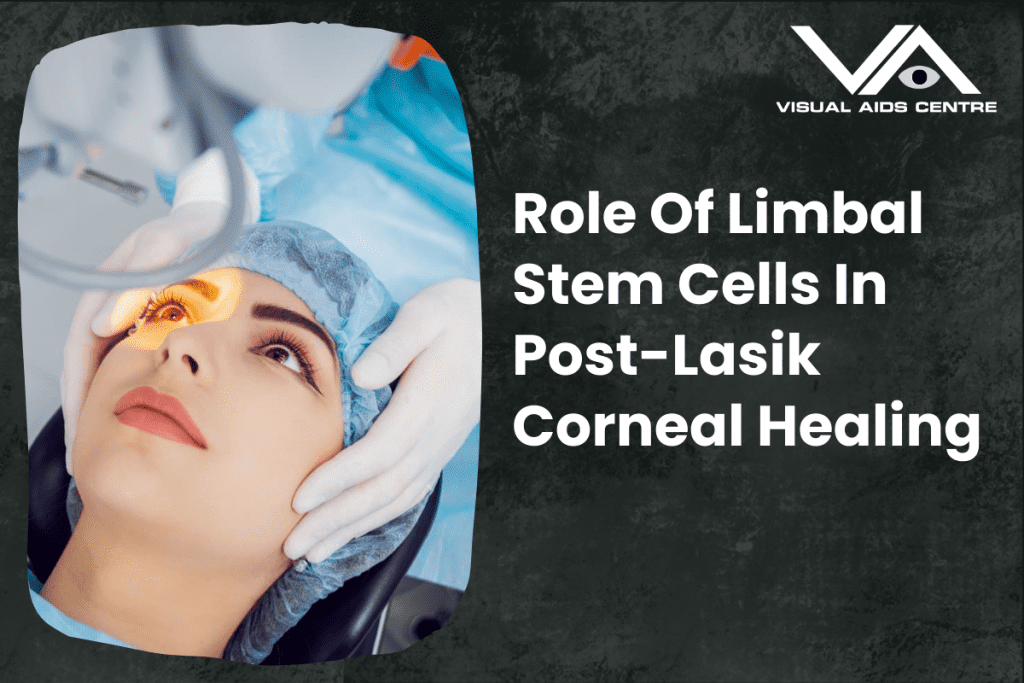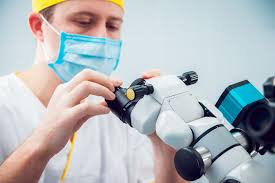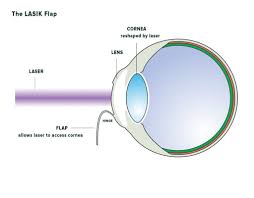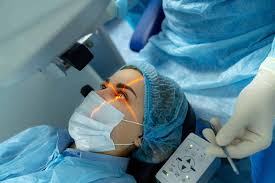Table of Contents
ToggleLimbal Stem Cells (LSCs) are vital for corneal healing after LASIK surgery by ensuring the regeneration and restoration of the epithelial layer, the primary protective barrier of the cornea.
Their unique ability to self-renew and differentiate makes them integral to maintaining corneal clarity and function after the surgical procedure.

Understanding Limbal Stem Cells and Their Unique Role in the Cornea
Limbal Stem Cells are specialised cells located in the limbus, the transitional zone between the cornea and the sclera. These stem cells are responsible for the maintenance, repair, and regeneration of the corneal epithelium.
- Self-Renewal Properties: LSCs are capable of sustaining a continuous supply of fresh epithelial cells by undergoing division.
- Differentiation Capabilities: They can differentiate into mature epithelial cells that rejuvenate and repair the corneal surface after injuries or surgical interventions such as LASIK.
- Barrier Function: These cells also act as a barrier to prevent conjunctival epithelial cells from invading the cornea.
Their unique position near the external environment ensures that the cornea has a rapid response mechanism for natural healing.
The Corneal Healing Process After LASIK Surgery
LASIK (Laser-Assisted in Situ Keratomileusis) reshapes the cornea to correct refractive errors. The procedure involves creating a corneal flap and ablating the underlying tissue with a laser. This results in both surface and sub-surface cellular disruptions, triggering a healing mechanism controlled largely by LSCs.
Stages of Corneal Healing Post-LASIK
1. Immediate Response Post-Surgery
Once LASIK is performed, epithelial cells around the flap edges begin to migrate quickly to cover the wounded area. This process is primarily initiated by limbal stem cells.
- LSC Activation: Limbal stem cells detect the injury and rapidly migrate to the affected zones of the cornea.
- Proliferation: LSCs amplify in number to produce epithelial progenitor cells.
2. Re-Epithelialisation Process
The epithelial gap left by the LASIK flap closure is efficiently bridged by daughter cells derived from LSCs. This prevents external pathogens and debris from entering the corneal stroma while maintaining transparency.
- Scar-free Regeneration: The absence of scars on the corneal surface is a testament to the robust role of LSCs in controlled and clean regeneration.
3. Long-Term Corneal Reorganisation
Over time, LSCs ensure that the epithelium’s structural integrity is preserved while contributing to homeostasis, which is essential for corneal function and visual clarity.
Challenges in LASIK Healing Due to LSC Deficiency
Limbal Stem Cell Deficiency (LSCD)—caused by trauma, chemical burns, or excessive UV exposure—can severely impair corneal healing. Post-LASIK patients with pre-existing LSCD may face complications such as incomplete epithelial closure, conjunctivalisation, and persistent corneal haze.
- Incomplete Re-Epithelialisation: Without adequate LSC activity, epithelial recovery is delayed, exposing corneal tissue to risks like infection or keratoconus development.
- Chronic Corneal Haze: A lack of functional LSCs can result in irregular epithelial repair, increasing the likelihood of scarring and haze, which compromises post-operative outcomes.
Careful screening of patients for potential LSCD is essential prior to conducting LASIK surgery to ensure effective healing post-procedure.
Factors Affecting Limbal Stem Cells Post-LASIK
Several factors influence the ability of Limbal Stem Cells to execute their healing functions after LASIK, including lifestyle, surgical precision, and even environmental conditions.
1. UV Light Exposure
Excessive UV exposure can accelerate oxidative stress in LSC-rich areas. UV rays can hinder their natural regenerative capabilities, resulting in delayed wound healing.
Prevention Tip: Use UV-blocking glasses or avoid direct sunlight in the immediate post-operative weeks for optimal healing.
2. Nutritional Deficiencies
Essential nutrients like Vitamin A and Omega-3 fatty acids directly support the health of limbal stem cells. Any deficiencies can impact their regeneration capacity.
Diet Suggestion: LASIK patients should incorporate foods that are rich in these nutrients to nourish their corneal epithelium indirectly.
3. Surgical Technique Variations
The precision of the LASIK flap creation and corneal ablation determines the extent of epithelial disruption. Proper handling during surgery reduces stress on limbal cells.
4. Dry Eye Syndrome (DES)
Dry Eye Syndrome is a common post-LASIK side effect that can adversely affect LSC activity by disrupting the ocular surface.
Management Tip: Artificial tears and regular hydration are recommended to maintain a healthy tear film, which facilitates LSC function.
Innovations in Promoting Limbal Stem Cell Function
Modern research and techniques have been directed towards enhancing the healing capacity of LSCs to achieve optimal post-operative outcomes for patients undergoing LASIK.
Stem Cell Therapy Enhancements
Emerging treatments aim to restore or replace damaged LSCs to support corneal healing. Cellular implants or in vitro regenerative techniques are being developed to counteract LSCD-related complications.
Bioengineered Scaffolds
Scientists are investigating the use of 3D-printed biomaterials that can act as scaffolds for transplanted LSCs, providing a stable environment for effective cell migration and proliferation.
Growth Factor-Infused Treatments
Topical growth factor formulations, such as epithelial growth factor (EGF) drops, are being researched to augment natural LSC functions post-surgery. These bioengineered solutions can accelerate re-epithelialisation.
Preserving Limbal Stem Cells for Future LASIK Candidates
For LASIK surgeons, ensuring the long-term functionality of limbal stem cells in patients is vital for optimal recovery. Here’s how patient care can help preserve these critical cells pre- and post-LASIK.
Pre-Operative Screening
Carefully evaluating corneal health and detecting early signs of LSCD ensures that patients with compromised cells receive alternative treatment plans.
Encouraging Post-Surgery Care
Providing comprehensive post-operative care instructions, including avoiding eye strain and environmental irritants, helps maintain limbal cell vitality during the recovery phase.
Long-Term Monitoring
Follow-up appointments to observe corneal healing and epithelial integrity allow surgeons to address any delays or complications in healing promptly.
Final Thoughts
The role of limbal stem cells in post-LASIK corneal healing is indispensable. These extraordinary cells initiate epithelial repair, restore corneal integrity, and preserve vision by acting as the foundation of the corneal healing process. From ensuring rapid re-epithelialisation to maintaining long-term homeostasis, their contribution cannot be overstated.
LASIK surgeons and researchers must focus on leveraging advancements in LSC research while educating patients on the importance of limbal cell health for seamless recovery. By combining expert surgical techniques, patient care, and novel therapies, we can unlock the full potential of limbal stem cells, ensuring clear vision and optimal outcomes for everyone undergoing LASIK surgery.













